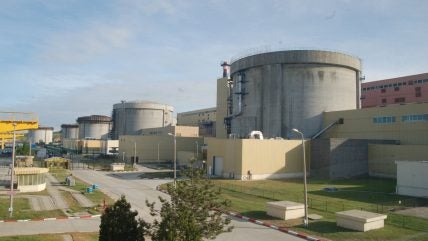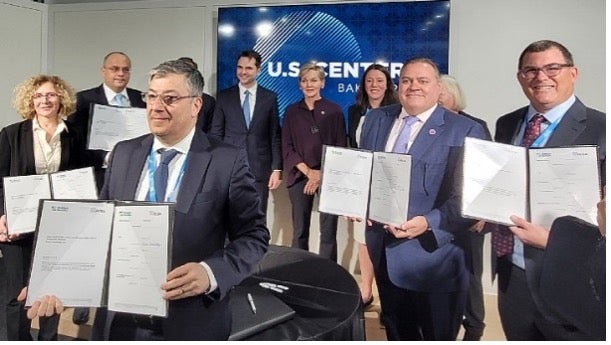
An engineering, procurement & construction management (EPCM) contract for the completion of units 3 and 4 at Romania’s Cernavoda NPP has been signed with the FCSA Joint Venture including Fluor, AtkinsRéalis, Ansaldo Nucleare and Sargent & Lundy Energie.
EnergoNuclear, a subsidiary of Romanian nuclear utility SN Nuclearelectrica (SNN) signed the contract during a ceremony at the United Nations COP29 climate change conference in Baku, Azerbaijan. Also attending the ceremony were Romanian Minister of Energy Sebastian Burduja, US Secretary of Energy Jennifer Granholm, and officials from Environment & Climate Change Canada and the Italian government.
The EPCM contract, with an estimated duration of 108 months, is structured in two phases, a limited notice to proceed phase (24-30 months) and the final notice to proceed stage phase (80-84 months). The second phase will be subject to commercial terms being further refined and agreed and a final investment decision being taken in line with the support agreement between the Romanian State and Nuclearelectrica. SNN said that the estimated value of the EPCM contract, was about €3.2bn ($3.4bn). Canada’s government is providing export financing support of CAD3bn ($2.1bn).
The Cernavoda site houses two Candu 6 reactors (units 1&2) on a site originally constructed for five. Unit 1 went into commercial operation in 1996 and unit 2 in 2007. Construction of three more units began, but was stopped in 1990 when unit 3 was 52% complete and unit 4 30% complete. The two 720 MWe operating units provide about 20% of Romania’s power. Unit 2 holds the world record for highest capacity factor of any nuclear reactor globally. Romania is also preparing for the life extension of unit 1 to 60 years.

In July the European Union issued a positive opinion on the technical and nuclear safety aspects of the construction of the two units, which have a scheduled operation date of 2030 for unit 3 and 2031 for unit 4.
Romania’s Energy Minister, Sebastian Burduja, said: “It is the most important project for the Romanian energy sector in recent decades. We have the strongest international partners with us to bring it to fruition by 2031-2032. Signing today’s contract required a considerable effort, on all levels: diplomatic, financial, legal. Once this investment is completed, in 7-8 years, Romania will provide over 30% of the national energy needs only through nuclear energy production. Today’s historic step is also a symbolic one: Romania is able to carry forward strategic projects devised 50 years ago and blocked by decades of hesitation, carelessness or lack of decision.”
Nuclearelectrica CEO Cosmin Ghita said: “Today marks a major milestone in the advancement and ultimately completion of Romania’s strategic Cernavoda NPP Units 3 and 4 project. The EPCM contract represents the very foundation of the project. We are honoured to work on this contract and project with highly professional, internationally recognised partners. Units 3 and 4, Candu technology, will provide Romania with energy security and clean energy in a safe and sustainable manner. Once units 3 and 4 are connected to the grid, 66% of Romania’s clean energy will be provided by nuclear energy, showcasing, one more time, the critical role of nuclear energy in deep decarbonisation.”
AtkinsRéalis said Cernavoda 3&4 would be first new Candu reactors built since 2007. Joe St Julian, President, Nuclear, AtkinsRéalis, said: “Candu technology has served Romania well and is the right choice for the next 60 years. The last seven Candu reactors built around the world, and the ongoing life extension of 10 Candu reactors in Ontario, have been conducted on time and on budget.” President & CEO Ian L Edwards noted that AtkinsRéalis is the sole commercial licensee of Candu technology. The contract “represents our first step in our expansion around the world as we aim to sell many more reactors”.
Candu reactors use heavy water (deuterium oxide) as a moderator and coolant, and are fuelled using natural uranium. They also allow for on-power refuelling and flexible fuel cycle options. The first commercial Candu reactors began operation in Canada in 1971. There are currently 27 Candu reactors in seven countries as well as 18 reactors in India based on Candu technology.






